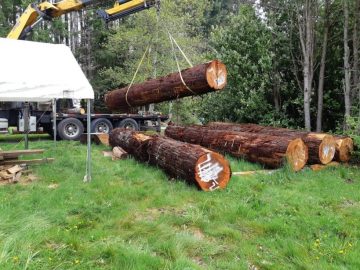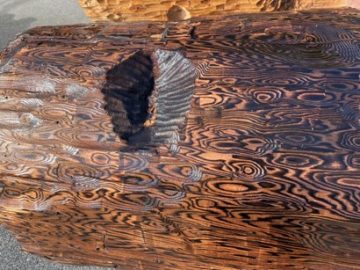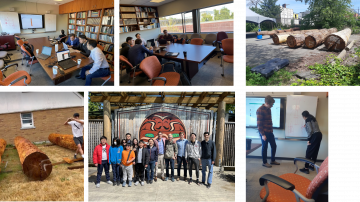
Background
The Indigenous community and The University of British Columbia have been working to promote Indigenous arts, culture, and heritage. In this project, five 20-foot-long timber segments will be connected form a 100-foot-tall timber sculpture. The project is led by artists Dave and Jocelyne Robinson of the Timiskaming First Nation, with the UBC Smart Structures team assisting with the structural engineering design. The structural design involves using state-of-the-art engineering to develop the connections between the 20-foot-long segments. The overarching goal of this project is to showcase the fusion of Indigenous art and state-of-art engineering.
Ten years ago, carver/sculptor and educator, Dave Robinson, had the dream to hand carve a 100-foot-tall cedar sculpture. To complete the project, Dave would begin to build a team to help with the momentous sculpture. Dave’s mother, Dr. Jocelyne Robinson, was the first member recruited. Dr. Robinson was recruited for her artistic design skills, understanding of sculptures, as well as her doctorate in Education. Dave and Jocelyne had been working on several projects together when Dave invited her to join him in the creation of this one. Damian Wilmann, Principal of Lord Byng Secondary School, was the second member recruited. Wilmann has been an instrumental partner by purchasing the logs and providing space to work on the logs. Students at Lord Byng also participated in the development of the sculpture. Wilmann’s participation and support have been integral to the completion and existence of the 100’ project. Dr. Tony Yang was the third member recruited. Given the massive scale of the project, specialized engineered connections are required to connect the sculpture. Dr. Yang and his team of graduate students, Fan Xie and Ben Ernewein, and the postdoctoral researcher, Dr. Xiao Pan, were tasked with evaluating the seismic performance and designing connections for the sculpture. Dave and Jocelyne have gained an appreciation for the expertise and enthusiasm Dr. Yang’s team have instilled in the project, and are excited to find ways for Indigenous science and Western science systems to complement each other. As new and exciting strategies and engineering possibilities have evolved, the team expects the project completion is in view in the coming months.
 |
 |
| The logs used in this project are Western Red Cedar from the coastal mountains of British Columbia | All of the logs were carved by hand using traditional tools and methods |
The UBC Smart Structures team has been developing an AI-aided scan-to-model pipeline to automatically scan the logs for use in computer modelling. Given the scale of the sculpture, novel high-capacity connections are being developed to tie the logs together. The completed project will stand over 100 feet tall, and it will be the tallest hand-carved sculpture in the world.

Dr Yang’s team is working together with the indigenous community to evaluate the seismic performance and design novel connections for the sculpture
About the Artists
David Robinson

David Robinson is an Algonquin artist/carver/sculptor from the Timiskaming First Nation. Robinson is also a graduate of the UBC Experimental School of Medicine. Robinson’s style can be understood by the way he considers time, space, and the ways in which the sculpture form is created. Robinson’s sculptures share a way of exemplifying the simple forms that reflect archetypal representations of their subject matter. Robinson’s work juxtaposes the elements of traditional First Nations pieces through an understanding of the relationship of nature in all living beings and the need to acknowledge the land and the people who inhabit it. Robinson regards his pieces as contemporary sculptures that are imbued by his First Nations philosophies. Robinson’s current public art sculptures located in Vancouver include Many Beings (2016), Thunder Child (2016), Dancing Flames (2017), Medicine Bowls (2020), Great Whale (2021), Alter (2020), Bean Around the World Bench (2020), Emergence (2020), Medicine Wheel Puzzle Project (2020), UBC Longhouse Bench (2020), UBC Farm Benches (2020), Red Cedar Heartwood River (2020), Medicine Snake (2020), Beaver (2020).
Dr. Jocelyne Robinson

Dr. Jocelyne Robinson is Algonquin from the Timiskaming First Nation in Northwestern Québec. Her Algonquin Anishinaabe name is Kokomisminan Dibik-kakizis Nésaywin (Grandmother Moon’s Breath). Jocelyne holds a bachelor’s degree in Fine Arts from Emily Carr University and a master’s degree in First Nations Curriculum in Education from Simon Fraser University. Jocelyne completed a doctorate in the Faculty of Education at the University of British Columbia. Jocelyne’s research work and traditional teachings focus on creating a sustainable dialogue for Indigenous and Western knowledge systems in education. Jocelyne is passionate about empowering future generations and encouraging the representation of Indigenous peoples in all science and all aspects of education. Jocelyne’s work within Indigenous communities has been through art and education followed by exhibited works in several Galleries. Her work was one of 24 artists featured in the magazine Sculpture along with 24 international artists participating in the Bellevue Washington Biennale Outdoor Exhibition. Jocelyne’s public art sculpture, Dancing to the Songs, was the first permanent Canadian sculpture in Shanghai, China. Her work was shortlisted for the Saskatchewan public art competition which was the largest First Nations public art commission in Canada. Jocelyne’s work has been exhibited in numerous art galleries namely the Gibson Art Gallery BC, the Reach Gallery BC, The Seymour Gallery BC, the Roundhouse Gallery BC, and the Warren G. Flowers Gallery QC.
Robinson has worked in collaboration with her son, Dave Robinson, on several public art sculptures including the cedar sculpture at Ecole Jules Quesnel Elementary (2020), the Vancouver School Board Whale Zoom carving (2020), the Grandfather Benches at Begbie Elementary (2021), Treasure Boxes at Britannia Secondary (2022), and Sculpture Dress at Lord Byng Secondary (2022). Recently, Jocelyne and Dave exhibited a 10ft x 2.5” x 4” cedar wood relief carving called Finding Mino Pimatsowin at the Minwashin Centre in Rouyn-Noranda. The sculpture will be permanently installed at the health centre in Ville Marie, Quebec.